The Pavilions at the Alhambra’s Court of the Lions: Graphic Analysis of Muqarnas
Abstract
:1. Introduction
1.1. Background. Brief Historical Data on Catastrophes and Restorations in the Court of the Lions
1.2. General Objectives and Methodology
2. Materials and Methods. Graphic Analysis of the Pavilions Muqarnas
2.1. The Pavilions and their Muqarnas Historical Images
2.2. New CAD Drawings Following Theoretical Principles on Muqarnas Grouping
2.3. Images Rendered from 3D Scanners
3. Results. Comparing Drawings
3.1. Comparing Different Pendentives
3.2. Comparing Different Arches
3.3. Comparing Different Floor Plans
3.4. Comparing Pendentives Elevations
4. Discussion. Geometric Deformations
4.1. Original Layout Deformations
4.2. Deformations by Construction
5. Conclusions
Author Contributions
Funding
Acknowledgments
Conflicts of Interest
References
- Alhambra, Generalife and Albayzín, Granada [World Heritage List]. Available online: https://whc.unesco.org/en/list/314 (accessed on 25 July 2020).
- Manzano-Martos, R. La Alhambra: El Universo Mágico de la Granada Islámica; Grupo Anaya: Madrid, Spain, 1992. [Google Scholar]
- Orihuela-Uzal, A. Casas y Palacios Nazaríes, Siglos XIII–XV; Fundación El Legado Andalusí: Granada, Spain, 1996; p. 37. [Google Scholar]
- García-Pulido, L.J. El Territorio de la Alhambra: Evolución de un Paisaje Remarcable; Patronato de la Alhambra y Generalife: Granada, Spain, 2013. [Google Scholar]
- Salinas-Rodríguez, J.L. El medio geológico en el enclave monumental. Cuadernos Alhambra 1997, 33, 47–56. [Google Scholar]
- Torres-Balbás, L. Los Reyes Católicos en la Alhambra. Al-Andalus XVI Crónica Arqueológica España Musulmana 1951, 16, 185–205. [Google Scholar]
- Casares-López, M. Las Obras Reales de la Alhambra en el Siglo XVI: Un Estudio de los Libros de Cuentas de los Pagadores Ceprián y Gaspar de León (1528–1627); Universidad de Granada: Granada, Spain, 2008. [Google Scholar]
- Brazille-Naulet, V.; Orihuela-Uzal, A.; García-Pulido, L.J. La Torre de Comares en peligro de ruina. Afecciones de la estructura más significativa de la Alhambra en los siglos XVI y XVII. In Defensive Architecture of the Mediterranean; UGR: Granada, Spain, 2020; Volume X, pp. 21–28. [Google Scholar] [CrossRef]
- Torres-Balbás, L. El Patio de los Leones. Arquitectura 1929, 11, 221–234. Available online: http://oa.upm.es/34174/ (accessed on 15 July 2020).
- Tito-Rojo, J. Los Jardines del Patio de los Leones y del Patio Alhambra. In El Patio Alhambra en el Crystal Palace; Abada Editores: Madrid, Spain, 2010; pp. 41–103. [Google Scholar]
- Sáez-Pérez, M.P. Estudio de Elementos Arquitectónicos y Composición de Materiales del Patio de los Leones. Interacciones en sus Casas de Deterioro. Tesis Doctoral Inédita, Universidad de Granada, Granada, Spain, 2004. [Google Scholar]
- Migoń, P. Cultural heritage and natural hazards. In Encyclopedia of Natural Hazards; Springer: Dordrecht, The Netherlands, 2013; pp. 135–140. [Google Scholar]
- Nicu, I.C. Natural hazards—A threat for immovable cultural heritage. A review. Int. J. Conserv. Sci. 2017, 8, 375–388. [Google Scholar]
- Gámiz-Gordo, A. Alhambra. Imágenes de Ciudad y Paisaje Hasta 1800; Fundación El Legado Andalusí: Granada, Spain, 2008; pp. 114–126. [Google Scholar]
- Almagro-Gorbea, A. El Legado de Al-Ándalus: Las Antigüedades Árabes en los Dibujos de la Academia; Real Academia de Bellas Artes de San Fernando/Fundación Mapfre: Madrid, Spain, 2015. [Google Scholar]
- Gámiz-Gordo, A. La Mezquita-Catedral de Córdoba. Fuentes gráficas hasta 1850. Al-Qantara Revista Estudios Árabes 2019, 40, 135–183. [Google Scholar] [CrossRef]
- Gámiz-Gordo, A.; Ferrer-Pérez-Blanco, I. A grammar of muqarnas: Drawings of the Alhambra by Jones and Goury (1834–1845). VLC Arquitectura. Res. J. 2019, 6, 57–87. [Google Scholar] [CrossRef]
- Sánchez-Gómez, C. El patio de los Leones de la Alhambra: Imagen fotográfica e historicidad de un espacio monumental. Cuadernos Alhambra 2009, 44, 50–83. [Google Scholar]
- Piñar-Samos, J.; Sánchez-Gómez, C. Oriente al Sur. El Calotipo y las Primeras Imágenes Fotográficas de la Alhambra, 1851–1860; Patronato de la Alhambra y Generalife: Granada, Spain, 2017. [Google Scholar]
- Giménez-Serrano, J. Manual del Artista y Del Viajero en Granada; J. A. Linares: Granada, Spain, 1846. [Google Scholar]
- Barrios-Rozúa, J.M. Una polémica en Torno a los Criterios Para Restaurar la Alhambra: Salvador Amador Frente a Narciso Pascual y Colomer (1846–1849). Reales Sitios Revista Patrimonio Nacional 2009, 106, 42–70. [Google Scholar]
- Serrano-Espinosa, F. Arquitectura y Restauración Arquitectónica en la Granada del Siglo XIX. La Familia Contreras; Tesis Doctoral Inédita: Universidad de Granada, Granada, Spain, 2014; Volume 1B, pp. 285–298. [Google Scholar]
- Vílchez-Vílchez, C. La Alhambra de Leopoldo Torres Balbás: Obras de Restauración y Conservación, 1923–1936; Editorial Comares: Granada, Spain, 1988. [Google Scholar]
- López-de-Arenas, D. Breve Compendio de la Carpintería de lo Blanco y Tratado de Alarifes; [Printed by Luis Estupiñan]: Sevilla, Spain, 1633. [Google Scholar]
- de San-Miguel, F.A.; Báez Macías, E. Obras de Fray Andrés de San Miguel; Universidad Nacional Autónoma de México: Mexico, D.F., Mexico, 1969. [Google Scholar]
- Nuere-Matauco, E. La Carpintería de Lazo: Lectura Dibujada del Manu-scrito de Fray Andrés de San Miguel; Colegio de Arquitectos en Málaga: Málaga, Spain, 1990. [Google Scholar]
- Nuere-Matauco, E. La Carpintería de lo Blanco: Lectura Dibujada del Primer Manuscrito de Diego López de Arenas; Ministerio de Cultura: Madrid, Spain, 1995. [Google Scholar]
- Dold-Samplonius, Y.; Harmsen, S.L. Muqarnas: Construction and reconstruction. In Architecture and Mathematics from Antiquity to the Future; Springer International Publishing: Cham, Germany, 2015; pp. 709–719. [Google Scholar] [CrossRef]
- Garofalo, V. A methodology for studying muqarnas: The extant examples in Palermo. Muqarnas 2010, 27, 357–406. [Google Scholar] [CrossRef] [Green Version]
- Palacios-Gonzalo, J.C.; Alkadi, R.M. Muqarnas domes and cornices in the Maghreb and Andalusia. Nexus Netw. J. 2018, 20, 95–123. [Google Scholar] [CrossRef]
- Karabörk, H.; Karasaka, L.; Yaldiz, E. A case study: Documentation method with close range photogrammetry of muqarnas which is to be an ornamentation type specific to the Islamic architecture. Procedia Earth Planet Sci. 2015, 15, 133–140. [Google Scholar] [CrossRef] [Green Version]
- Ferrer-Pérez-Blanco, I.; Gámiz-Gordo, A.; Reinoso Gordo, J.F. New drawings of the Alhambra: Deformations of muqarnas in the pendentives of the Sala de la Barca. Sustainability 2019, 11, 316. [Google Scholar] [CrossRef] [Green Version]
- Prieto-Moreno, F. Obras recientes en la Alhambra y el Generalife. Cuadernos Alhambra 1967, 3, 153–157. [Google Scholar]
- Rubio-Domene, R. Yeserías de la Alhambra: Historia, Técnica y Conservación; Patronato de la Alhambra y Generalife: Granada, Spain, 2010. [Google Scholar]
- Reinoso-Gordo, J.F.; Gómez-Blanco, A.J.; Rodríguez-Moreno, C.; León-Robles, C.A. Cultural heritage conservation and sustainability based on surveying and modeling: The case of the 14th century building Corral del Carbón (Granada, Spain). Sustainability 2018, 10, 1370. [Google Scholar] [CrossRef] [Green Version]


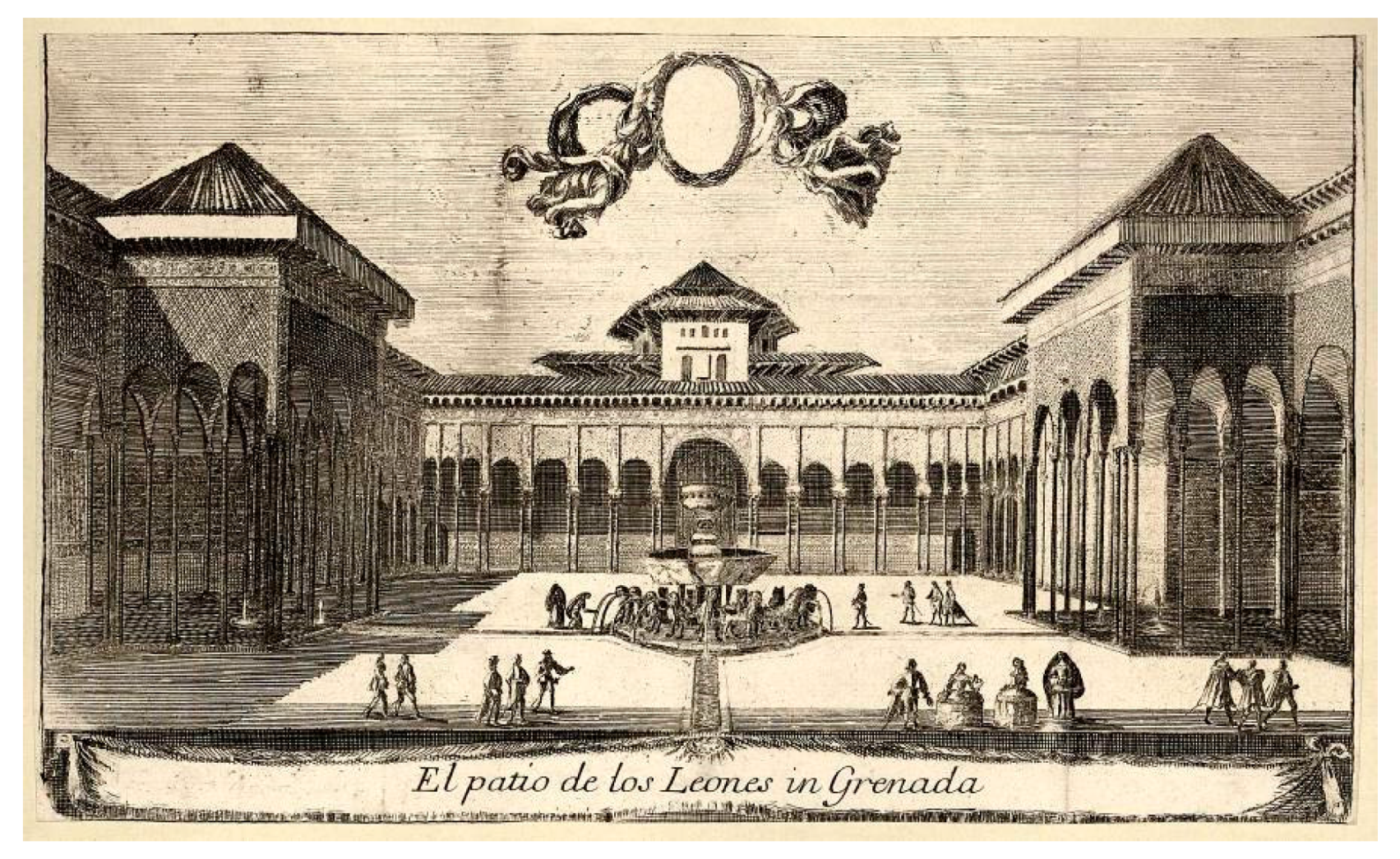
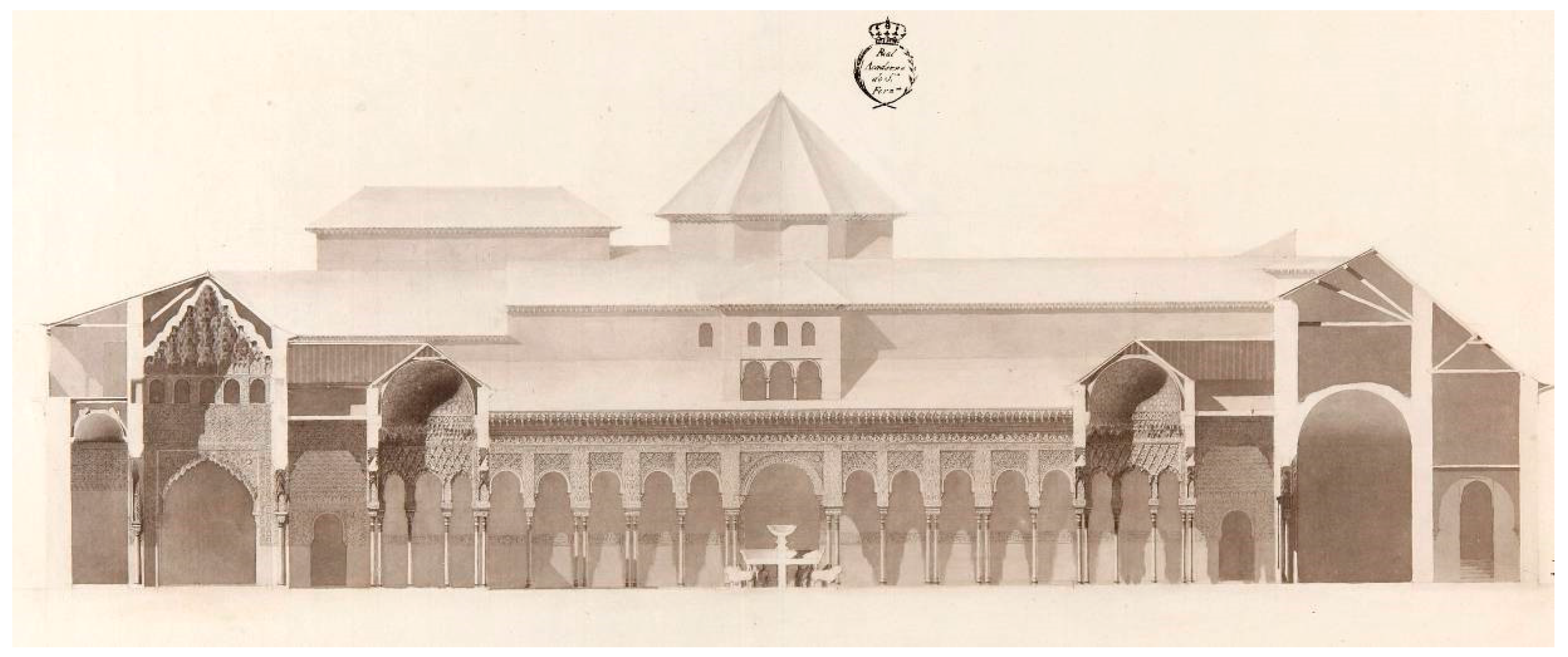
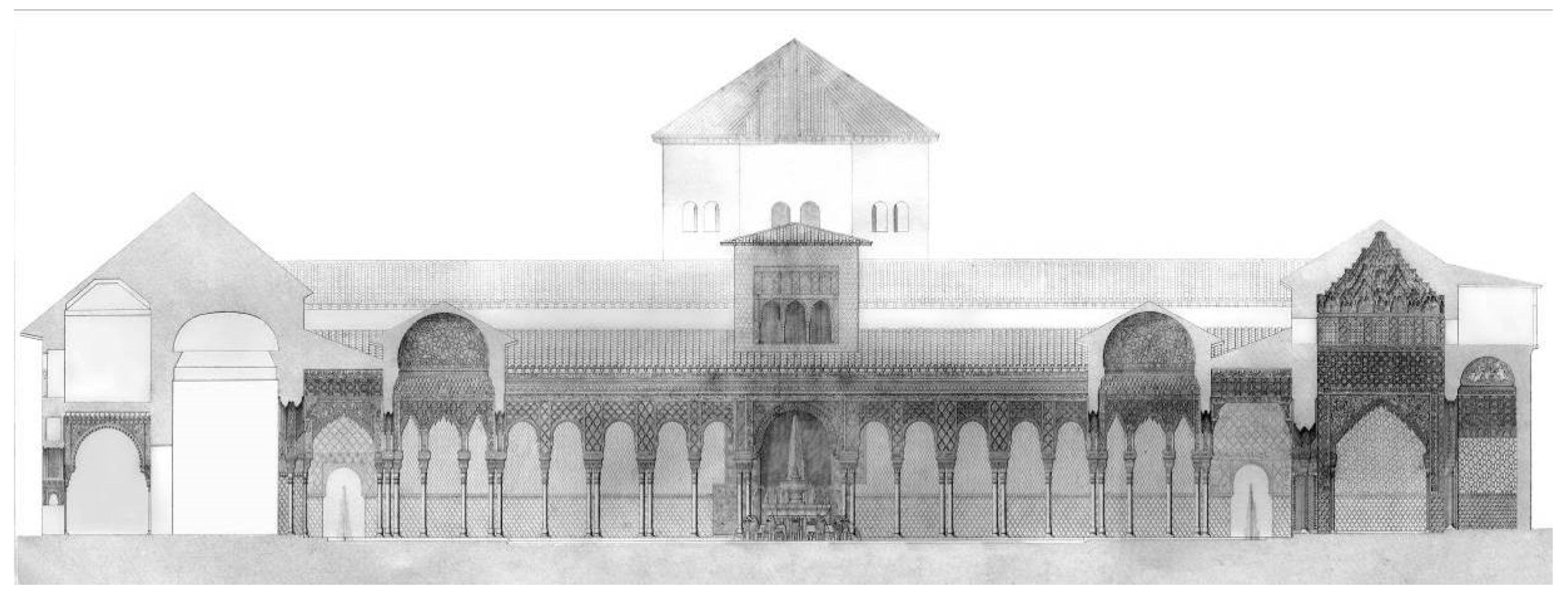
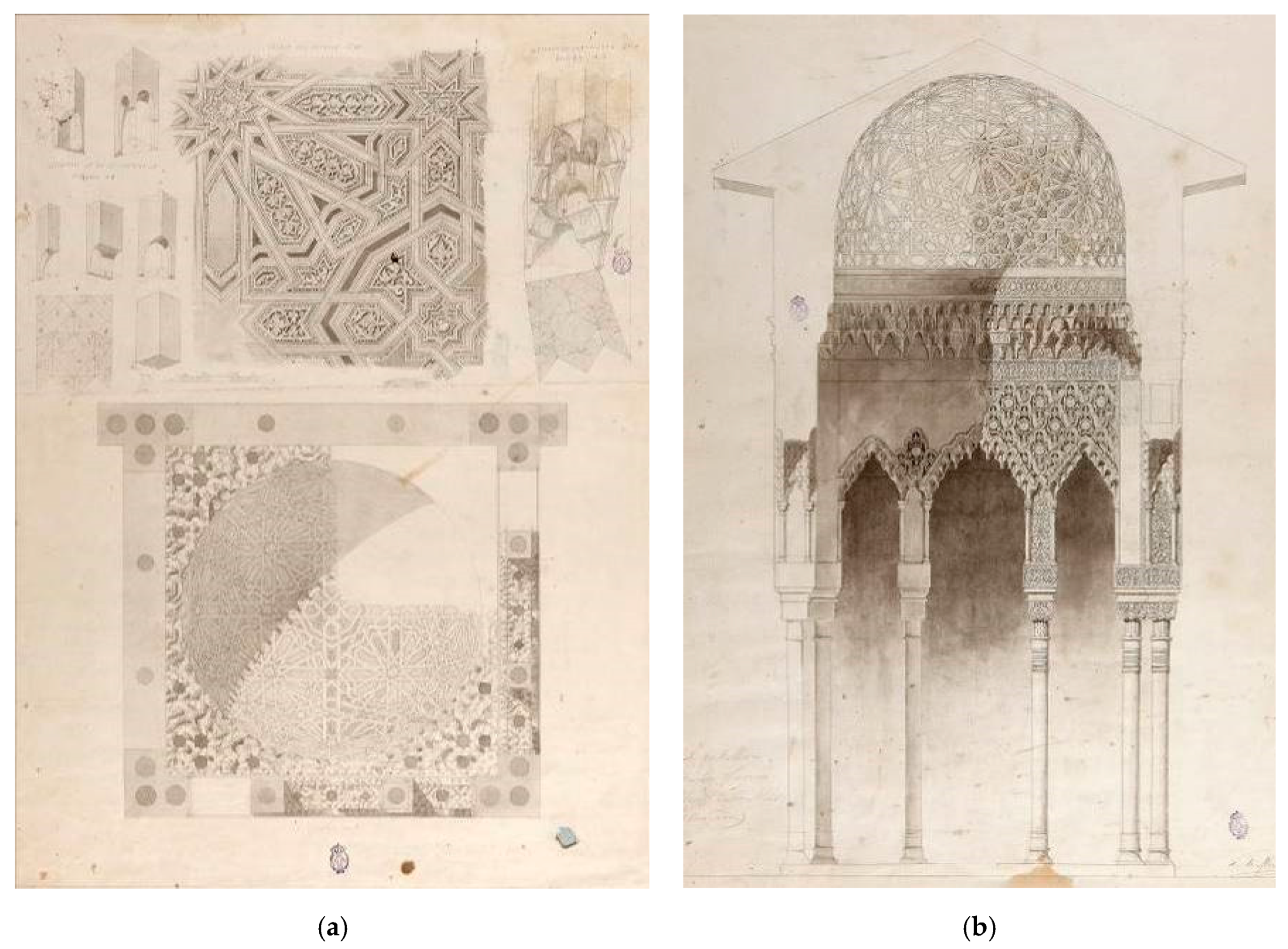










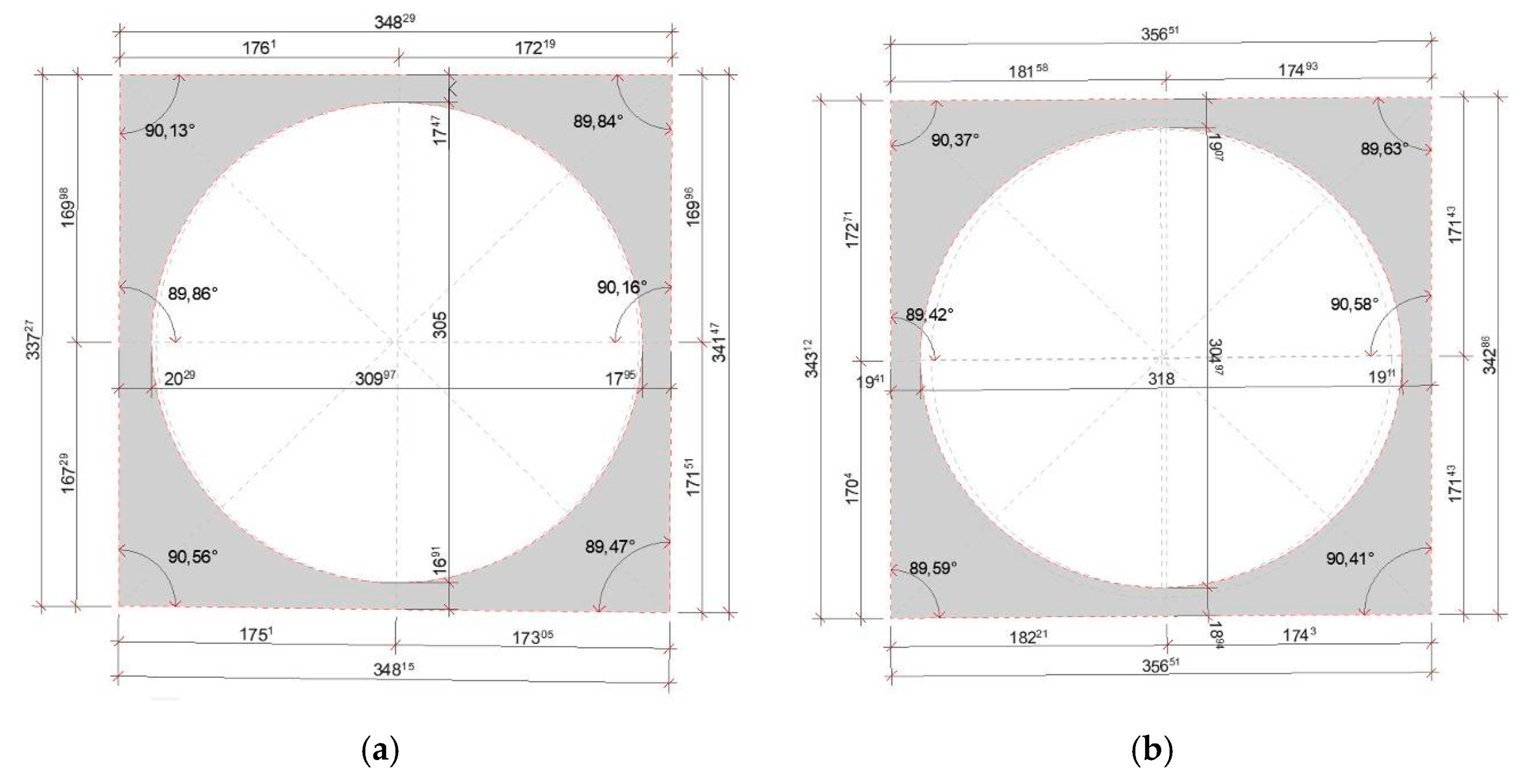


© 2020 by the authors. Licensee MDPI, Basel, Switzerland. This article is an open access article distributed under the terms and conditions of the Creative Commons Attribution (CC BY) license (http://creativecommons.org/licenses/by/4.0/).
Share and Cite
Gámiz-Gordo, A.; Ferrer-Pérez-Blanco, I.; Reinoso-Gordo, J.F. The Pavilions at the Alhambra’s Court of the Lions: Graphic Analysis of Muqarnas. Sustainability 2020, 12, 6556. https://0-doi-org.brum.beds.ac.uk/10.3390/su12166556
Gámiz-Gordo A, Ferrer-Pérez-Blanco I, Reinoso-Gordo JF. The Pavilions at the Alhambra’s Court of the Lions: Graphic Analysis of Muqarnas. Sustainability. 2020; 12(16):6556. https://0-doi-org.brum.beds.ac.uk/10.3390/su12166556
Chicago/Turabian StyleGámiz-Gordo, Antonio, Ignacio Ferrer-Pérez-Blanco, and Juan Francisco Reinoso-Gordo. 2020. "The Pavilions at the Alhambra’s Court of the Lions: Graphic Analysis of Muqarnas" Sustainability 12, no. 16: 6556. https://0-doi-org.brum.beds.ac.uk/10.3390/su12166556




